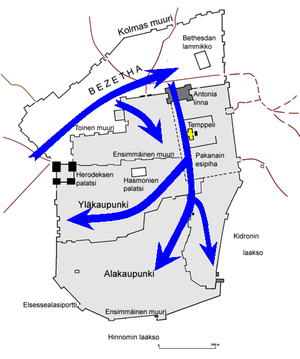Destruction of the Temple
| Siege of Jerusalem (70 CE) | ||||||||||
|---|---|---|---|---|---|---|---|---|---|---|
| Part of the First Jewish–Roman War | ||||||||||
 Progress of the Roman army during the siege. |
||||||||||
|
||||||||||
| Belligerents | ||||||||||
|
|
||||||||||
| Commanders and leaders | ||||||||||
| Titus | Simon Bar Giora | |||||||||
| Strength | ||||||||||
| 70,000 | 20,000–30,000 | 10,000 | ||||||||
| Casualties and losses | ||||||||||
| Unknown | 30,000 | 10,000 | ||||||||
| According to Josephus, 1.1 million non-combatants died in Jerusalem, mainly as a result of the violence and famine. Many of the casualties were observant Jews from across the world such as Babylon and Egypt who had travelled to Jerusalem wanting to celebrate the yearly Passover but instead got trapped in the chaotic siege. He also tells us that 97,000 were enslaved. Matthew White, The Great Big Book of Horrible Things (Norton, 2012) p.52, estimates the combined death toll for the First and Third Roman Jewish Wars as being approximately 350,000 |
||||||||||
Roman victory
The Siege of Jerusalem in the year 70 was the decisive event of the First Jewish–Roman War. The Roman army, led by the future Emperor Titus, with Tiberius Julius Alexander as his second-in-command, besieged and conquered the city of Jerusalem, which had been occupied by its Jewish defenders in 66.
The siege ended with the sacking of the city and the destruction of its Second Temple. The destruction of both the first and second temples is still mourned annually as the Jewish fast Tisha B'Av. The Arch of Titus, celebrating the Roman sack of Jerusalem and the Temple, still stands in Rome.
Despite early successes in repelling the Roman sieges, the Zealots fought amongst themselves, and they lacked proper leadership, resulting in poor discipline, training, and preparation for the battles that were to follow. At one point they destroyed the food stocks in the city, a drastic measure thought to have been undertaken perhaps in order to enlist a merciful God's intervention on behalf of the besieged Jews.
Titus began his siege a few days before Passover, surrounding the city, with three legions (V Macedonica, XII Fulminata, XV Apollinaris) on the western side and a fourth (X Fretensis) on the Mount of Olives to the east. If the reference in his Jewish War at 6:421 is to Titus' siege, though difficulties exist with its interpretation, then at the time, according to Josephus, Jerusalem was thronged with many people who had come to celebrate Passover. The thrust of the siege began in the west at the Third Wall, north of the Jaffa Gate. By May, this was breached and the Second Wall also was taken shortly afterwards, leaving the defenders in possession of the Temple and the upper and lower city. The Jewish defenders were split into factions: John of Gischala's group murdered another faction leader, Eleazar ben Simon, whose men were entrenched in the forecourts of the Temple. The enmities between John of Gischala and Simon bar Giora were papered over only when the Roman siege engineers began to erect ramparts. Titus then had a wall built to girdle the city in order to starve out the population more effectively. After several failed attempts to breach or scale the walls of the Fortress of Antonia, the Romans finally launched a secret attack, overwhelming the sleeping Zealots and taking the fortress by late July.
...
Wikipedia
